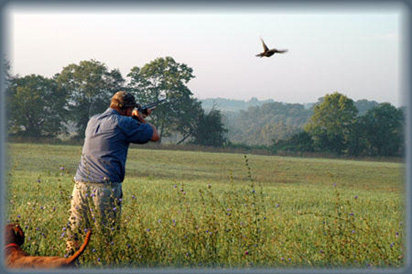

 The Accurate Reloading Forums
The Accurate Reloading Forums  THE ACCURATE RELOADING.COM FORUMS
THE ACCURATE RELOADING.COM FORUMS  Hunting
Hunting  Bird Shooting
Bird Shooting  TX Lethality Study On Doves- Lead vs Steel Shot
TX Lethality Study On Doves- Lead vs Steel ShotGo  | New  | Find  | Notify  | Tools  | Reply  |  |
One of Us |
Texas will help settle on best methods By RAY SASSER / The Dallas Morning News Saturday, September 5, 2009 SANTA ANNA, Texas – It looked like a scene from Monty Python meets Texas dove season, but the exercise was no joking matter. Thirteen Texas Parks and Wildlife observers hunkered on low stools behind Oregon shooting expert Tom Roster. As birds flew past his stand location, Roster blasted away, killing some doves cleanly, crippling some that flew away and missing others outright. The observers used laser range finders to gauge the shooting distances, quizzed Roster on whether he thought he had hit birds that kept flying and made copious observations about flight angles and whether birds fell dead or had to be chased down. It was a training session for TP&W's dove lethality study. There's no grading on the curve. Observers who failed to score at least 95 percent accuracy on their observations were removed from the team. Once dove season started Sept. 1, the trained observers were paired with hunters in Brown and Coleman counties. The goal was to collect a minimum of 1,500 doves taken with one shot. Each dove was tagged with a number corresponding to the score sheet. It's the most intense scientific study ever done on dove shooting, geared up as pressure mounts to ban the use of lead ammunition in the hunting of any migratory game birds. Lead shot was banned from waterfowl hunting in the 1980s, and Roster was at the center of that hunting controversy. He pioneered work with steel shot, basically teaching waterfowl hunters the ballistic differences between steel shot and lead shot. Roster testified as an expert witness in court cases involving the lead shot ban for waterfowl hunting. That ban occurred because ducks, geese and other water birds were eating lead pellets dispersed by the thousands in traditional hunting spots across America. It remains unknown whether birds mistake the small, round, dark pellets as edible seeds or ingest them as a grit material necessary for digestion. Birds that ingest lead pellets die of lead poisoning. Eagles and other birds of prey that eat lead-poisoned birds are also affected. TP&W's lethality program is the first of a two-pronged study that is expected to cost $1.5 million and take several years to complete. The second part, which has yet to be designed, will examine doves for evidence of lead poisoning. Vernon Bevill, TP&W's small-game program director, said Texas officials were asked four years ago to get on board the nontoxic shot movement for dove hunting. But they weren't satisfied with the science in studies conducted by other states. "Dove hunting is a $300 million business in Texas," Bevill said, "and we feel obligated to our hunters to base any decisions we make on science rather than political correctness." Bevill said the shotgun lethality portion of the study is being done first because officials wanted Roster involved in the research and he's approaching retirement age. Roster designed a variety of 12-gauge shotgun loads for the tests. Some are loaded with nontoxic shot in various sizes, others with lead pellets. The shells are loaded by an independent contractor in coded boxes. Hunters in the tests do not know what loads they are shooting. The hunters were chosen randomly from Harvest Information Program surveys and should reflect the skill level of an average Texas dove hunter. Doves taken with a one shot are carefully tagged, frozen and shipped to a laboratory. Each bird will be X-rayed, then plucked. Entry and exit wounds will be counted, wound depths will be measured, broken bones and vital organs will be examined and the findings will be charted on an anatomical diagram. "This is a huge deal for the future of dove hunting," Bevill said. "Forty percent of all shotgun ammunition sales are dove loads. Surveys indicate that dove hunters buy the cheapest ammunition they can find. We don't know how many will stop hunting if they're forced to shoot shells that are two or three times as expensive." Answers expected from the steel shot lethality study • What shotgun loads work best for shooting doves. • What shotgun chokes are best for dove hunting. • How many shots are required for each dove bagged. • How many doves are wounded and lost per bird bagged. | ||
|
| One of Us |
Dick's Sporting Goods occasionally sells steel ammo almost as cheaply as lead. I think if the manufacturers would gear up for it and mass produce it in the same volume as lead, we could buy steel ammo for almost the same price as lead. That would make it an easy decision for most. I've been consider shooting steel #6's this year. I think I'll try it and see if the hunting results are different than last week with lead. If your hunting dog is fat, then you aren't getting enough exercise. | |||
|
| Powered by Social Strata |
| Please Wait. Your request is being processed... |
|
 The Accurate Reloading Forums
The Accurate Reloading Forums  THE ACCURATE RELOADING.COM FORUMS
THE ACCURATE RELOADING.COM FORUMS  Hunting
Hunting  Bird Shooting
Bird Shooting  TX Lethality Study On Doves- Lead vs Steel Shot
TX Lethality Study On Doves- Lead vs Steel Shot

Visit our on-line store for AR Memorabilia

